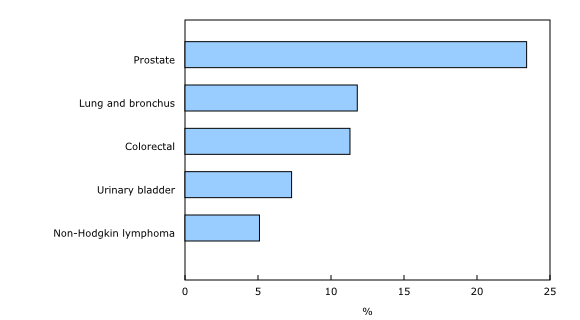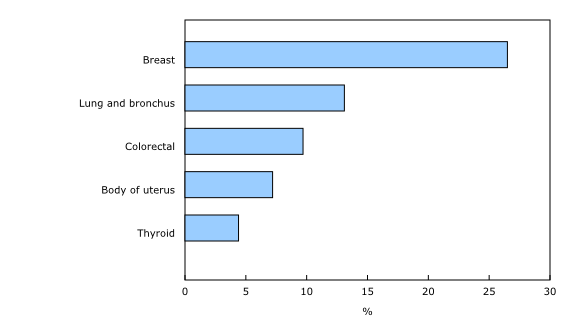Cancer incidence in Canada, 2018
Archived Content
Information identified as archived is provided for reference, research or recordkeeping purposes. It is not subject to the Government of Canada Web Standards and has not been altered or updated since it was archived. Please "contact us" to request a format other than those available.
Released: 2021-05-19
Over 156,000 new cases of cancer were diagnosed in 2018, according to the Canadian Cancer Registry, a national database that has been collecting data on new cancer diagnoses since 1992. This represents 546 new cancer diagnoses per 100,000 people. In keeping with the previous years, the five most commonly diagnosed cancers remained breast (13.0%), lung and bronchus (12.4%), prostate (12.0%), colorectal (10.5%) and urinary bladder (4.9%). Together, these five cancer types accounted for over half of the cancer diagnoses in 2018. Cancer incidence is strongly influenced by broad factors such as screening, prevention and population aging. Consequently, incidence trends tend to evolve slowly and a long period of observation is usually required to detect changes over time. However, the potential impact of the temporary shutdown of screening services in the early months of the COVID-19 pandemic will need to be assessed as more recent data become available.
Advancing age is the most important risk factor for most cancers. In 2018, fewer than 2% of all cancers were diagnosed among people under age 30, whereas over 70% were diagnosed among those aged 60 and older. The average age at diagnosis for all cancers combined increased slightly from 65.8 years in 1992 to 66.9 in 2018 because of population aging and a decrease in other causes of death.
Largest increase in average age at diagnosis for Kaposi sarcoma and skin cancers over last 26 years
A closer examination of specific cancer types reveals some important changes over time. For instance, the average age at diagnosis for Kaposi sarcoma, a rare form of connective tissue cancer that mostly affects HIV-infected individuals, increased by 26.2 years, from 40.5 years in 1992 to 66.7 in 2018. Such a major change can be in large part attributed to improvements in treatment. The introduction of antiretroviral therapy in the mid-1990's is known to have played a major role in preventing or delaying the progression from HIV to AIDS, which in turn resulted in a lower incidence and older ages at diagnosis for Kaposi sarcoma.
Similarly, melanoma of the skin (up 9.8 years, from 55.1 years to 64.9) and other less common forms of non-epithelial skin cancer (up 8.8 years, from 60.9 years to 69.7) were also characterized by a large increase in their average age at diagnosis, partly as a result of greater awareness and safer practices in terms of skin protection against ultraviolet radiation in some subgroups of the population.
Decrease in average age at diagnosis for prostate and colorectal cancers over last 26 years
On average, very few cancers were diagnosed at a younger age in 2018 than in 1992. However, prostate cancer was down 3.5 years, from 72.7 to 69.2 years of age, even though the Canadian Task Force on Preventive Health Care stopped recommending prostate-specific antigen screening for healthy men of any age in 2014. Among the cancers for which screening programs were in place, only colorectal cancer was, on average, diagnosed earlier in 2018 (69.0 years) than in 1992 (69.7 years), mostly owing to a two-year decrease in the age at rectal cancer diagnosis (from 68.5 years in 1992 to 66.4 years in 2018).
Younger age at diagnosis for testicular cancer and some blood cancers
While most new cancer cases tend to be diagnosed among the older segment of the population, some remain consistently associated with children, adolescents and young adults. In 2018, acute lymphocytic leukemia (ALL) had the youngest average age at diagnosis of all cancers (27.1 years), followed by testicular cancer (36.8 years) and Hodgkin lymphoma (43.3 years). About half of the reported cases were diagnosed by age 15 for ALL, by age 35 for testicular cancer and by age 40 for Hodgkin lymphoma.
Older age at diagnosis for urinary tract cancers
On the other hand, many cancers are typically diagnosed at more advanced ages, with an average above 70 years of age. This was the case for most urinary tract cancers, such as those of the ureter (74.5 years) and urinary bladder (72.6 years). Other cancers that tend to be diagnosed at older ages include mesothelioma (73.7 years), which is a rare cancer often diagnosed among people with a history of asbestos exposure, lip cancer (73.0 years), gallbladder cancer (72.2), lung and bronchus cancer (71.7 years) and pancreatic cancer (71.4 years).
Note to readers
The Canadian Cancer Registry (CCR) is a population-based registry that includes data collected and reported to Statistics Canada by each provincial or territorial cancer registry. The goal of the person-based CCR is to collect information about each new primary cancer diagnosed among Canadian residents since 1992.
Cancer incidence refers to the number of new cases of cancer in a population over a given period, usually one year. The cancer incidence rate is typically expressed as the number of new cancer cases per 100,000 people.
Cancer incidence data for Quebec are not available for diagnosis years 2011 and onward. For tables 13-10-0111-01 and 13-10-0747-01, cancer incidence estimates for Canada, excluding Quebec, were produced for all diagnosis years.
As the CCR is updated annually with new records and changes to previous records, the incidence for any given diagnosis year may change from one release to the next. In particular, delays in the reporting of new cases to Statistics Canada typically result in undercounts of cases which are more pronounced in the most recently reported diagnosis year. Generally, the reporting delay ranges between 2% and 3% nationally. In addition, death certificate-only cases were not reported by Nova Scotia for 2018, nor by Manitoba since 2013. As a consequence, about 130 cases are not reflected in the current version of the database but will be reported to the CCR within the coming years.
The category "all cancers combined" refers to all invasive cancers, excluding non-melanoma skin cancer but including in situ urinary bladder cancer.
Contact information
For more information, or to enquire about the concepts, methods or data quality of this release, contact us (toll-free 1-800-263-1136; 514-283-8300; STATCAN.infostats-infostats.STATCAN@canada.ca) or Media Relations (613-951-4636; STATCAN.mediahotline-ligneinfomedias.STATCAN@canada.ca).
- Date modified:



